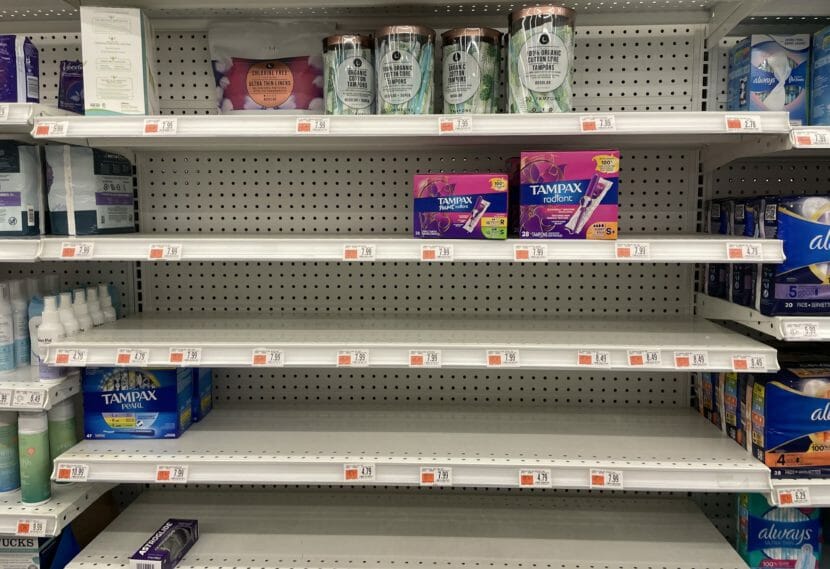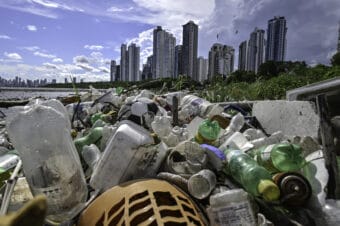
People who menstruate are saying it’s hard to find tampons on store shelves across the U.S. right now, as supply chain upsets reach the feminine care aisle.
“I just went to 5 different Walgreens [and] the shelves are CLEARED,” said one Twitter user this past week, while people on Reddit have posted about empty shelves going back months.
The shortage stems from a combination of factory staffing challenges, transportation bottlenecks, and the rising costs of key raw materials used to make the products, tampon makers say.
CVS, Target and Walgreens said in statements to NPR that they were aware of a limited tampon supply at some stores. A spokesperson for CVS said that, in recent weeks, suppliers haven’t been able to fulfill the full orders placed by the company. Both companies said they’re working with tampon makers to replenish store inventory as soon as possible.
Walgreens said its shortages “may only be in specific brands while we navigate the supply disruption,” but that its website is updated with the latest store-level inventory.
Dana Marlowe, the founder of I Support the Girls, an organization that provides menstrual products for people with economic hardship, says the shortage has been happening for longer than most people realize.
Marlowe says her group has seen a large drop in tampon donations in recent months. The organization received half as many tampons this year compared to the same time last year and over 60% less than in 2020.
“Our shelves our bare,” Marlowe told NPR.
Procter & Gamble, makers of Tampax products, told NPR the supply problem is temporary and that “the Tampax team is producing tampons 24/7 to meet the increased demand.”
P&G, which owns the biggest market share of menstrual products, said in an April earnings call that sourcing and transporting raw materials for menstrual products, as well as getting products on trucks to retailers, “continues to be costly and highly volatile.”
It’s not just tampons. Edgewell, which owns multiple menstrual product brands, says that its inventory of Carefree and Stayfree liners and pads sank alongside that of its Playtex and o.b. tampons.
The company attributes the lower quantities to staff shortages prompted by omicron variant infection waves, one affecting its U.S. manufacturing facility late last year and another affecting its Canadian supplier early this year.
“We have been operating our manufacturing facilities around the clock to build back inventory and anticipate returning to normal levels in the coming weeks,” an Edgewell spokesperson said in a statement.
As awareness of the shortage spreads, grocery delivery company Instacart said people are buying up where they can.
“We’re observing an increase in stock-up behavior,” the company said Thursday.
Tampon sales on the platform saw a 50% hike between Monday and Wednesday, with preferred brands now harder to find. As of Wednesday, Instacart said that its tampon “found rate” — how often shoppers are able to find the item a customer orders — dipped down to 72%, the lowest rate since the start of the pandemic in 2020.
It’s another supply chain issue affecting women
It’s another supply chain problem where women are bearing the brunt of the cost, as mothers struggle to feed their babies during the baby formula shortage.
Time first reported on the tampon shortage last week, noting that it’s lasted longer than other shortages, like toilet paper and cleaning supplies, early on in the pandemic. Decision-makers in the supply chain and CEOs of manufacturers are mostly men, the magazine reported.
Tampons are also getting more expensive due to inflation. A year after announcing increased prices on feminine care products, P&G said in the April earnings call that ongoing supply chain constraints led to another price hike on the products, which will go into effect in mid-July.
The average price for tampons rose by nearly 10% in the year through last month, Bloomberg reported citing NielsenIQ data, because of rising costs of the materials used. The cost of pads shot up by about 8%. The materials that make up tampons and pads, including cotton, rayon, fluff pulp and plastic, have been in high demand for use in masks and other medical products during the pandemic. Extreme drought in Texas, diesel prices and Russia’s invasion of Ukraine also tightened the supply of those goods.
I Support The Girls founder Marlowe said that existing stigmas and taboos around menstruation make it difficult to garner national attention and action needed to solve the scarcity problem. It’s one that affects vulnerable groups the most, she said.
She’s met women who don’t have the resources to make multiple trips to the store, she said, and have resorted to unsafe methods. “They’re using cardboard and duct tape, ripped up sheets,” and other unsanitary items, she said.
Copyright 2022 NPR. To see more, visit https://www.npr.org.9(MDEwMjQ0ODM1MDEzNDk4MTEzNjU3NTRhYg004))



